Archived Mold Remediation Blog Posts
Year-Round Ways to Prevent Mold | SERVPRO of San Diego East
3/24/2025 (Permalink)
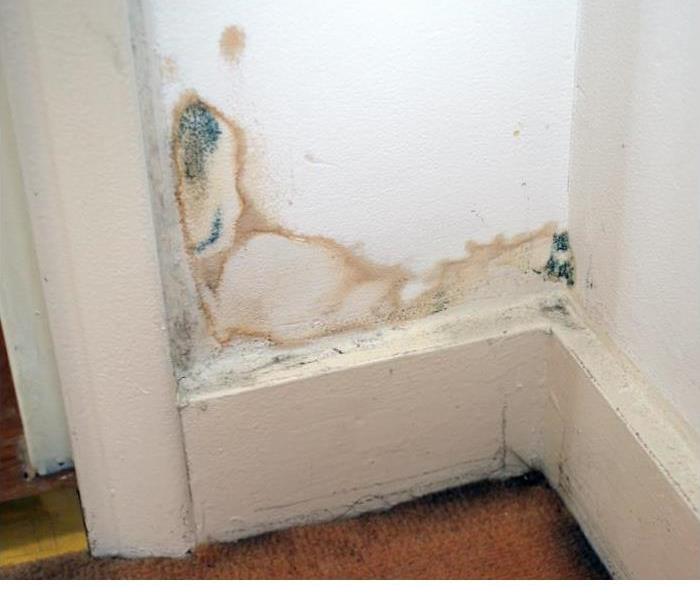 For more information, visit our website at SERVPRO of San Diego East.
For more information, visit our website at SERVPRO of San Diego East.
Mold can sneak up on you when you least expect it, and in a city like San Diego, which enjoys mild winters and warm summers, it’s important to stay vigilant. While mold growth is often associated with wet, humid conditions, it can appear at any time of year, especially if the right conditions are present. SERVPRO® of San Diego East is here to share a few helpful tips for homeowners to keep mold at bay, regardless of the season.
Know Your Seasons and How They Affect Mold GrowthSan Diego is known for its mild climate, but that doesn’t mean mold won’t thrive here. While most people think of mold as a problem during rainy weather, it can also grow in the warmer months. During the summer, San Diego’s humidity levels can rise, and without proper ventilation, areas of your home can become breeding grounds for mold spores.
Winter also brings its own set of challenges. Though temperatures rarely dip below freezing, winter rains are a common occurrence in San Diego. When you combine rain with cooler temperatures, condensation can form on windows, walls, and pipes, creating the perfect environment for mold growth. Being proactive during these transitional periods can make all the difference.
Keep Your Home Dry: The Best Defense Against MoldThe best way to prevent mold growth is to keep moisture levels in your home under control. Here are some essential tips:
- Ventilate: Make sure areas prone to moisture, like bathrooms, kitchens, and laundry rooms, are well-ventilated. Use exhaust fans to help reduce humidity.
- Repair Leaks: A small leak can lead to big problems. Inspect pipes, roofs, and windows for any signs of leaks, and repair them as soon as possible.
- Dehumidify: In warmer months, using a dehumidifier can help maintain optimal humidity levels, keeping mold at bay.
- Monitor Condensation: In cooler months, pay extra attention to condensation on windows and walls. Wipe up excess water and consider using moisture-absorbing products to prevent mold growth.
SERVPRO of San Diego East recommends inspecting high-risk areas of your home regularly, especially after storms or periods of high humidity.
Don’t Wait—Act Fast!Mold can spread quickly if left unchecked, leading to costly repairs and potential health risks. If you notice any signs of mold in your home, don’t wait to address the issue. SERVPRO of San Diego East is ready to assist with mold inspections and remediation services. Contact us today to learn more about how we can help protect your home from mold growth year-round.
For more information, visit our website at SERVPRO of San Diego East.
Stop Mold Growth During Winter to Keep Your Home Safe | SERVPRO of San Diego East
1/7/2025 (Permalink)
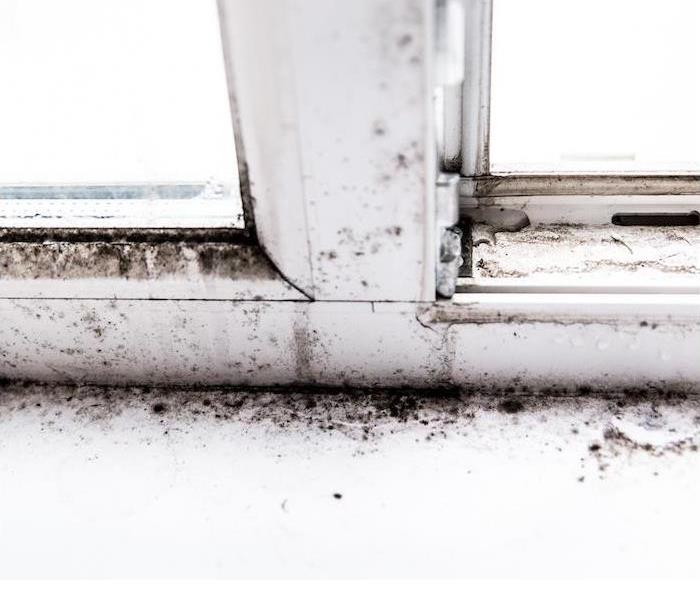 Prevent mold growth this winter by managing humidity, ventilating your home, and addressing condensation.
Prevent mold growth this winter by managing humidity, ventilating your home, and addressing condensation.
Mold is not just a summer problem; it can thrive even during the winter months, especially in places like San Diego, where the winter season brings mild but moist weather. Although San Diego doesn’t face freezing temperatures often, the average winter lows hover around the mid-40s to mid-50s. These conditions, combined with rainy spells, create a perfect environment for mold to grow. So, how can you protect your home from mold during these cooler months?
Why Mold Growth Increases in WinterMold loves damp, humid environments, and while San Diego winters are relatively mild compared to other parts of the country, we still see enough moisture to be a concern. The combination of rainy weather and warm indoor heating can create condensation around windows and in poorly ventilated areas. This is a haven for mold spores that can spread quickly if left unchecked.
Key Steps to Prevent Mold Growth1. Control Indoor Humidity LevelsEven during the winter, San Diego homes can experience high humidity levels. Use dehumidifiers and ensure your home’s humidity stays below 50%. If you’re using a heating system, make sure it’s not excessively drying or over-humidifying the air.
2. Ensure Proper VentilationWhile it may be tempting to seal up your home during the cooler months, it’s crucial to keep areas like kitchens and bathrooms well-ventilated. Open windows periodically and use exhaust fans when cooking or showering to expel excess moisture from your home. SERVPRO of San Diego East advises paying special attention to rooms that don’t get much airflow, as stagnant air can lead to mold growth.
3. Keep an Eye on CondensationWith the temperature differences between indoors and outdoors, condensation can form on windows and walls. Wipe down any excess moisture, and consider installing double-pane windows to reduce this effect. Keep an eye out for water damage after rainstorms, as San Diego’s unpredictable winter weather can sometimes surprise you.
What to Do If Mold AppearsIf you notice mold in your home, don’t try to remove it yourself. Attempting DIY mold remediation can often make the problem worse. Mold spores are tricky and can spread if not properly contained. Instead, call in professionals like SERVPRO of San Diego East, who are experienced in safe and effective mold removal.
Keeping your home mold-free during winter is essential for a safe and healthy living environment. If you suspect or spot mold, don’t hesitate to take action.
For more guidance or if you need professional assistance, visit SERVPRO of San Diego East. Our expert team is ready to help you tackle mold and any other winter-related home damage. Stay safe and mold-free this winter!
8 Tips to Prevent Mold in Your Vacation Rental
7/17/2024 (Permalink)
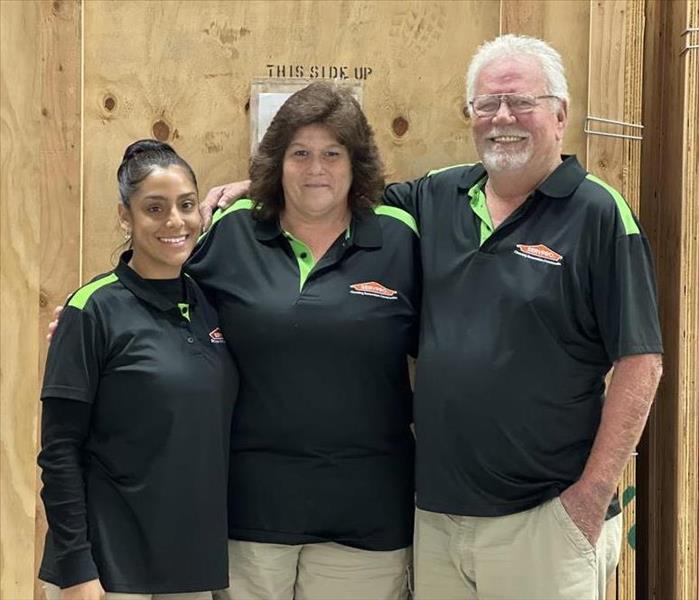 Our SERVPRO of San Diego East team can provide detailed advice and services to keep your property in excellent condition.
Our SERVPRO of San Diego East team can provide detailed advice and services to keep your property in excellent condition.
As a vacation rental owner, maintaining a mold-free property is essential for ensuring guest satisfaction and protecting your investment. Mold can quickly turn a guest’s dream vacation into a nightmare and result in negative reviews, which can hurt your rental business. Here’s how you can protect your vacation rental from mold with some effective strategies.
Keeping Your Vacation Rental Mold-Free
- Regular Inspections
Make it a routine to inspect your property for signs of mold and moisture, especially before and after the property is occupied. Check common problem areas like bathrooms, kitchens, and any places with plumbing. Look for water stains, leaks, or condensation issues, which are precursors to mold growth.
- Enhance Air Circulation
Proper ventilation is crucial in preventing mold. Ensure that your property has adequate airflow. Use ceiling fans, exhaust fans, and occasionally open windows to help reduce moisture. Encourage guests to use bathroom and kitchen fans regularly to keep air moving.
- Control Humidity
Invest in a good-quality dehumidifier to help maintain the humidity levels below 60%, which is recommended to hinder mold growth. In humid climates, this can be especially important in preventing the damp conditions in which mold thrives.
- Quick Response to Water Problems
Any spills, leaks, or flooding should be addressed immediately to prevent the moisture from seeping into floors, walls, and furniture. Make sure your guests know how to contact maintenance quickly in case of such issues.
- Use Mold-Resistant Products
When updating or repairing your rental, choose mold-resistant materials such as paints, drywall, and fabrics. These products can be particularly effective in high-moisture areas like bathrooms and kitchens.
- Keep It Clean
Regular and thorough cleaning can help prevent mold growth. Ensure that bathrooms and kitchens are kept dry and well-ventilated. Provide guests with cleaning supplies and encourage them to wipe down surfaces where moisture may accumulate.
- Maintain Gutters and Drainage
Ensure that your property’s gutters are clean and free from debris to prevent water buildup. Proper exterior drainage is also crucial to steer water away from the foundation, which can be a significant factor in preventing mold.
- Educate Your Guests
Include information in your welcome book about the importance of preventing mold, such as using exhaust fans and managing humidity. Simple guidelines can empower guests to help maintain the property during their stay.
Protecting your vacation rental from mold is crucial for the longevity of your property and the satisfaction of your guests. Regular inspections, proper humidity control, and good cleaning practices are key strategies to prevent mold. By taking these proactive steps, you can ensure that your property remains a top choice for vacationers looking for a comfortable and healthy place to stay.
For more information on mold prevention and maintenance for vacation rentals, consider consulting with mold remediation professionals, such as our SERVPRO of San Diego East team, who can provide more detailed advice and services to keep your property in excellent condition.
Everything You Need to Know About Bathroom Mold: Causes, Prevention, and Removal
3/13/2024 (Permalink)
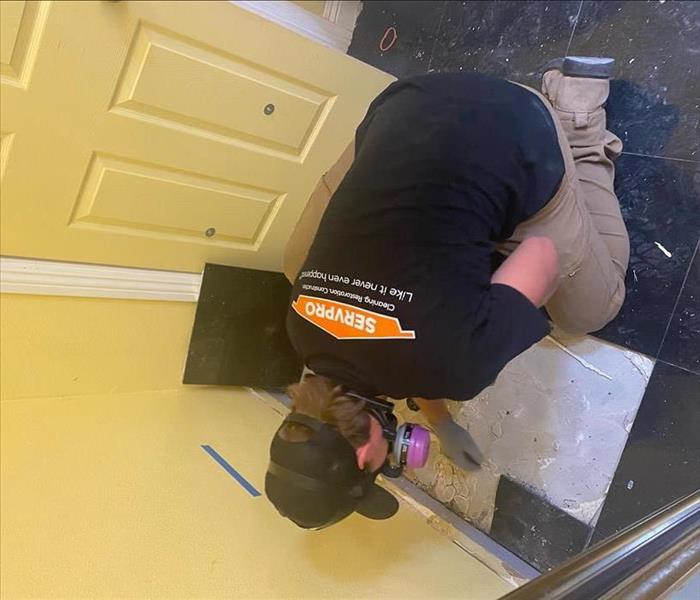 In this blog, we will explore the causes, prevention, and removal of mold in the bathroom.
In this blog, we will explore the causes, prevention, and removal of mold in the bathroom.
Mold growth in the bathroom is a common problem due to the high moisture levels found in this area. Not only is bathroom mold unsightly, but it can also deteriorate surfaces and cause potential health risks. Understanding the causes of bathroom mold, implementing preventive measures, and knowing how to effectively remove it is essential for maintaining a clean and healthy bathroom environment. In this blog, we will explore the causes, prevention, and removal of mold in the bathroom.
Causes of Mold in the Bathroom
Excess Moisture: Bathrooms are prone to excess moisture due to activities like showering, bathing, and washing. This moisture, along with the lack of ventilation, creates an ideal breeding ground for mold spores to grow and thrive.
Poor Ventilation: Inadequate ventilation can lead to moisture buildup, encouraging mold growth. Bathrooms with no or insufficient windows, exhaust fans, or proper airflow can trap moisture and promote the development of mold.
Leakages: Leaking pipes, faucets, and fixtures contribute to excess moisture in the bathroom. These hidden sources can go unnoticed for an extended period, creating the perfect environment for mold to flourish.
Prevention of Mold in the Bathroom
Proper Ventilation: Install an exhaust fan or use a window to facilitate air circulation and remove excess moisture from the bathroom. Ensure the fan is appropriately sized for the room and vented to the outside to prevent mold spores from circulating back into the bathroom.
Regular Cleaning: Regularly clean and dry bathroom surfaces to prevent mold growth. Wipe down wet surfaces such as shower walls, tubs, and sinks after each use. Use a squeegee or towel to remove excess moisture and discourage mold growth.
Fix Leaks: Promptly repair any leaks or water damage in pipes, faucets, or fixtures to prevent moisture accumulation. Regularly inspect and maintain plumbing systems to avoid potential mold problems.
Reduce Humidity: Use a dehumidifier or open windows to reduce humidity levels in the bathroom. Lowering humidity discourages mold growth and promotes a healthier bathroom environment.
Removal of Mold from the Bathroom
Safety Precautions: Before starting the mold removal process, take necessary safety precautions, such as wearing gloves, goggles, and a mask to prevent exposure to mold spores. Ensure the area is well-ventilated to minimize inhalation of mold particles.
Cleaning Products: Use mold cleaning products that are specifically designed for bathroom mold remediation. Look for products that contain ingredients such as sodium hypochlorite or hydrogen peroxide, which are effective in killing mold spores. Follow the instructions on the product for proper use and safety.
Scrubbing and Drying: Scrub the moldy area with a brush or sponge and the mold cleaning product. Thoroughly rinse the area and ensure it is completely dry. Drying the area prevents further mold growth and reduces the chances of moisture-related issues.
Professional Mold Remediation: When dealing with extensive or persistent mold growth, it is advisable to seek professional mold remediation services. Trained professionals, like SERVPRO®, can accurately assess the extent of mold damage, ensure proper removal, and address the underlying causes to prevent future mold recurrence.
Preventing and removing mold in the bathroom is vital for maintaining a clean and healthy environment. By addressing the causes of bathroom mold, implementing preventive measures, and using appropriate cleaning products, you can effectively control mold growth. Regular cleaning, proper ventilation, and prompt repair of leaks are key preventive strategies. If mold growth persists or becomes extensive, it is best to consult professionals to ensure thorough and safe mold remediation.
How to Get Rid of Mold Smell in Your Home
11/14/2023 (Permalink)
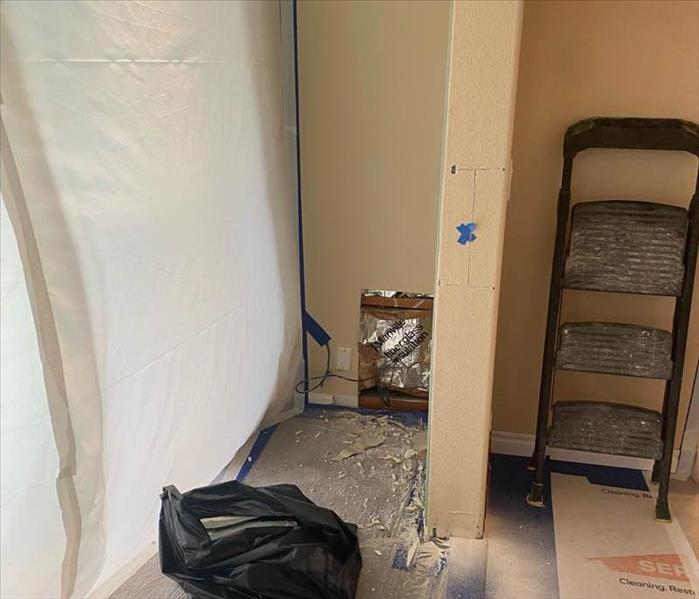 One common issue that can impact your living space is the unpleasant mold smell.
One common issue that can impact your living space is the unpleasant mold smell.
San Diego homeowners take pride in their properties, and maintaining a fresh, clean home is essential. One common issue that can impact your living space is the unpleasant mold smell. In this blog, we'll explore effective ways to eliminate that moldy odor from your home and ensure it stays fresh and inviting.
Identifying the Mold Smell
Mold odor can be quite distinctive and is often described as musty, damp, or earthy. If you notice this odor in your home, here's what you need to do:
- Locate the Source: Start by identifying areas in your home where the smell is most pronounced. Common culprits include damp basements, bathrooms, or areas that have experienced water damage.
- Inspect for Visible Mold: Check for visible mold growth on surfaces like walls, ceilings, or even hidden areas like crawlspaces and attics. Mold may be the source of the odor.
Effective Ways to Eliminate Mold Smell
To get rid of the mold smell, follow these steps:
- Ventilation: Proper ventilation is crucial in preventing and reducing mold odors. Open windows and use fans to increase air circulation in your home. Fresh air can help dissipate the musty smell.
- Remove the Source: If you find mold growth, it's important to address it at its source. Clean and remove the mold using appropriate cleaning agents. If the issue is extensive, consider professional mold remediation.
- Dehumidify: Mold thrives in high humidity conditions. Use a dehumidifier to maintain indoor humidity levels between 30-50%. This will discourage mold growth and help eliminate the odor.
- Baking Soda: Place bowls of baking soda in areas with mold smell. Baking soda acts as a natural deodorizer and can absorb odors effectively.
- Activated Charcoal: Activated charcoal is another excellent odor absorber. You can place charcoal pouches or containers in the affected areas.
- Air Purifiers: Consider using air purifiers with HEPA filters to remove airborne particles, including mold spores, and improve indoor air quality.
- Professional Help: If the mold odor persists despite your efforts, it may be time to consult professionals like SERVPRO® of San Diego East for comprehensive odor removal and mold remediation services.
Getting rid of the mold smell in your San Diego home is essential for a pleasant living environment. By following these tips, you can effectively eliminate mold odors and prevent their return. Remember that timely action and proper maintenance are key to ensuring your home always smells fresh and inviting. If you require expert assistance in addressing mold issues or persistent odors, don't hesitate to contact our SERVPRO® team for professional solutions and peace of mind.
Everything You Need to Know About Testing for Mold in Your Home or Workplace
5/8/2023 (Permalink)
Mold is a type of fungus that grows in warm, damp environments. It can be found almost anywhere, but it's particularly common in homes with poor ventilation or with moisture problems. There are many different types of mold and they all look different depending on what they're growing on (wood, paper or fabric).
Mold can grow almost anywhere there is water damage, under sinks or bathtubs and between walls and floors. Behind cabinets or baseboards, in attics where insulation has been wet by rainwater leakage through roof shingles and even inside your refrigerator if food spills over onto shelves that aren't cleaned regularly enough!
Signs of Mold
- Musty odors
- Visible mold growth (e.g., black-green stains)
- Discoloration on walls or ceilings
Testing for Mold
There are several ways to test for mold. The first and most obvious is visual inspection, which can be done by anyone with a trained eye and an understanding of what they're looking at. The second method is using a mold test kit, which allows you to collect samples from your home or workplace and send them off for lab testing. A third option is hiring a professional inspector who will come out to perform tests on site and give you their expert opinion about what's going on in your space.
Preventing Mold Growth
Reduce humidity levels. The ideal relative humidity for most homes is between 30% and 50%. If you have a dehumidifier, use it to reduce the moisture in your home. If you don't have one, try to keep windows open when possible and run fans during humid weather.
In order to ensure that your home is safe, it is best to hire a professional mold remediation company. These companies are trained in removing affected materials and cleaning up the affected area. They will also be able to tell you if there are any other areas of concern in your home that need attention.
Effective Cleaning
If you choose not to hire a professional company, then make sure that you follow these steps. Remove all affected materials from the house (such as drywall or carpeting). Clean and sanitize all surfaces with soap and water before replacing them back into place; this includes walls, ceilings, floors etc.
Protecting Your Employees During Mold Removal
It is essential to protect your employees during mold removal. Follow safety protocols. Wear protective gear, including full body suits and respirators. Provide air filtration systems in the area where you're working to keep mold spores from spreading throughout your workplace or home.
Mold can grow almost anywhere there's moisture. The best way to prevent mold growth is by keeping surfaces dry by using fans during humid weather, keeping humidity levels low inside homes/offices using dehumidifiers when necessary, and call a professional if you think your property suffers from mold damage in the workplace.
Mold 101: Covering the Basics
1/24/2023 (Permalink)
Mold is a fungus that can grow in any damp area of your home and it's not always easy to identify. This guide will help you understand what mold is, where it comes from and how to get rid of it permanently.
What is Mold?
Mold is a fungus that reproduces by making spores. Spores are microscopic and can be invisible to the naked eye. Molds come in all shapes, sizes, and colors. They may be fuzzy or moldy looking and they will usually be some shade of green, black, white, or gray.
Molds reproduce by making spores that spread through the air and settle on surfaces where they can germinate into colonies of the mold with new generations of spores that continue to spread throughout your home or office space.
Where Does it Come From?
Mold is found everywhere, even in the air we breathe. It's also present in our food and on our pets. In fact, mold doesn't need to eat anything to survive — it can grow on wood, paper, and other organic material as long as there is moisture present.
Mold grows best when there's plenty of moisture around (think humid environments), but it can also grow in dry areas if they're warm enough. It will thrive in wet areas such as bathrooms or kitchens where there are leaks from pipes or roof damage; basements with poor ventilation; floors covered with damp carpeting; roofs with leaky gutters; under sinks without adequate drainage holes and windows without screens.
How Does it Spread?
Mold spores are microscopic and float through the air. They can travel through ventilation systems, be carried on shoes, clothing, and other personal items, or be carried by pets.
When it Comes to Mold, Knowledge is Power
Mold spores are everywhere; they're carried by air currents and wind, so no place is completely free from mold contamination—you just have to use common sense when determining if you need professional help to clean up an infestation problem.
It’s important to know exactly where mold comes from and how it spreads so you can protect yourself and your family. If you have any questions about removing mold from your house, please feel free to contact us here at SERVPRO of San Diego East for more information!






 24/7 Emergency Service
24/7 Emergency Service




